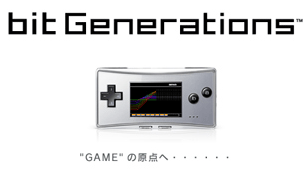Yet another in-preparation-for-[ENIAROF][3] post. This time we’re looking at a recent series of small video games that inspired us for the design of the workshop. The series is called [bitgenerations][1], and is further proof that [Nintendo][4] currently is hovering just about as close as a multinational corporate video game company can to [coolness][5]. Just when it looked like the Gameboy platform was on its last legs (well, maybe it still is), Nintendo releases this very elegant, simple and very playable series of more or less abstract games. 3xd matrixes and pixelshaders are totally absent here, we’re talking hardcore pixels. Some of it is so simple that it could almost have been designed for the Atari 2600. It certainly feels like a nod to [Nanoloop][6] (which really opened up the Gameboy platform), especially when you listen to the soundtracks which have been designed with a lot of care, and un certain goût for 4-bit noise generators.
The original of the whole lot is Soundvoyager which I like to play while walking around Aix-en-Provence. No, that doesn’t get me hit by a bus, because Soundvoyager is a game you play entirely by listening to the audio. You can easily play the game without looking at the screen, and indeed little by little the images dissapear from the screen as you play anyway, requiring you to navigate within the various games entirely by using your ears. It’s a suprising concept, and is one of those things you have to play in order to understand. But here are some videos anyway, just to give you an idea:
The key to playing is having a good pair of headphones, as all the games use left-right stereo panning.
Some other interesting games are Orbital and Coloris:
Although it isn’t as beautiful as things like lia’s work, it’s definitely trying to wander around the same territories, especially games like Dotstream which is one of my favorites: instead of moving sprites, you draw directly onto a scrolling background layer (probably mode 0 in Gameboy programming-lingo). Since the background image is basically a buffer, I’m figuring they’re just drawing directly into it. But since that’s also a tile-only graphics mode, maybe they’re programming in mode 5 (8-bit color, maximum resolution) and creating their own scrolling routine (might be easier).
Going back to games like Scramble, you are in a side-scrolling landscape and have to avoid objects, with the added twist of having to avoid the robot players that are also drawing in the same environment.
If you’re interested in purchasing these games, you can find them at Play-Asia, although they’re probably easy to find on some filesharing network as well, although I don’t know which one. (ok, so, I like the packaging…) For those that are participating in ENIAROF, I will be bringing all of them so you can try them firsthand.


